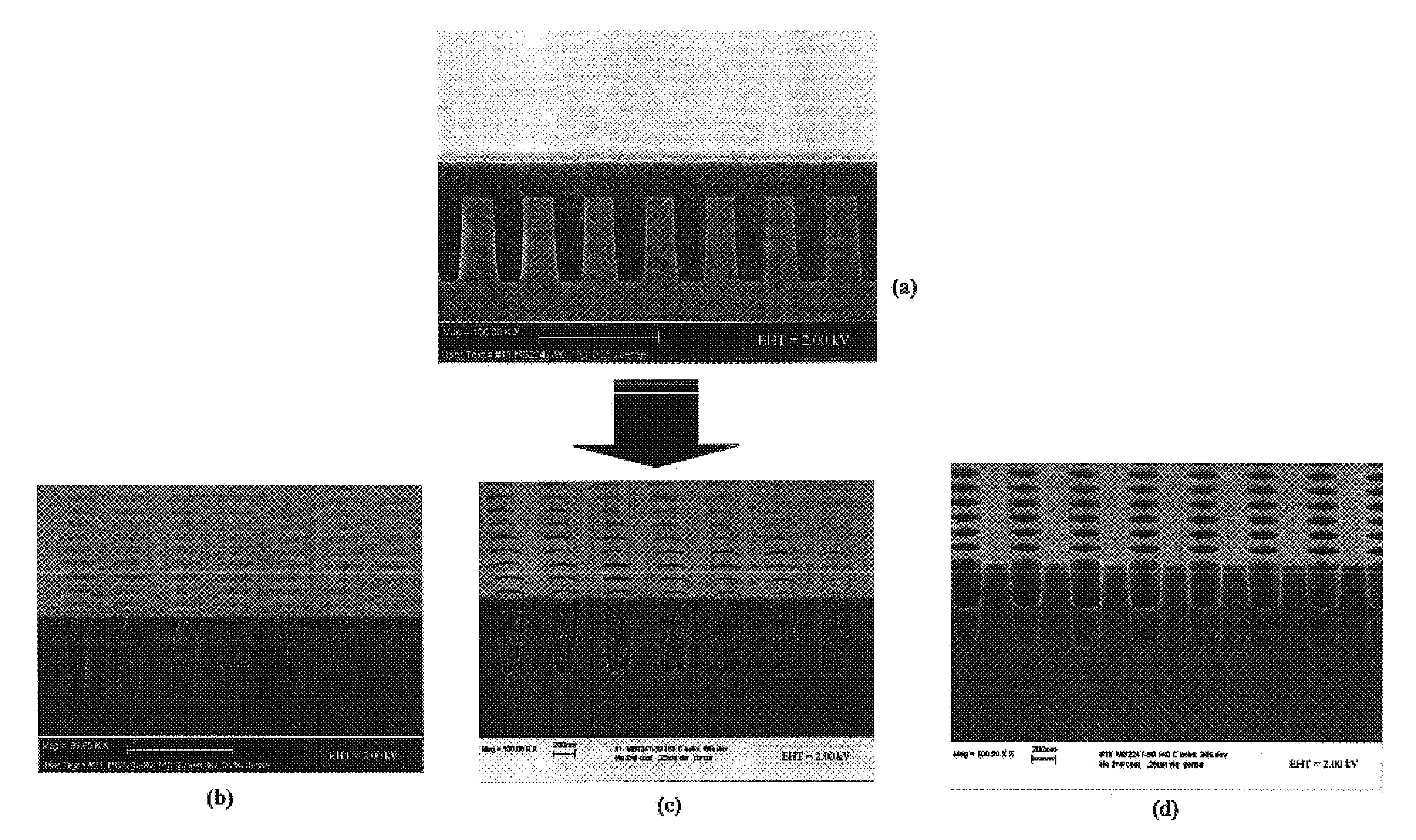Developer-soluble materials and methods of using the same in via-first dual damascene applications
a technology of development-soluble materials and damascenes, applied in the field of new dual damascene methods, can solve the problems of reducing manufacturing complexity and cost, reducing patterning and etching processes, and more complex integrated circuit devices, so as to reduce fencing or crown formation, low bias, and poor etch selectivity
- Summary
- Abstract
- Description
- Claims
- Application Information
AI Technical Summary
Benefits of technology
Problems solved by technology
Method used
Image
Examples
example 1
Preparation of Slower-Developing, Acetal Photoresist-Compatible Composition
[0064]The composition of this example was made by mixing the following ingredients together:[0065]55.0 g of the polymer solution prepared above (5.5 g polymer solids and 49.5 g PGME);[0066]16.5 g of the dye solution prepared above (3.3 g dye solids and 13.2 g PGME);[0067]1.67 g of MY720 (Ciba-Geigy);[0068]21.57 g of PGME; and[0069]36.12 g of PGMEA.
[0070]The total weight of the composition mixture was 130.86 g, with 8% solids.
[0071]The composition was spin applied at 1,500 rpm for 60 seconds onto silicon wafers and then baked at 175° C. for 60 seconds using a proximity bake plate. The film thickness of the coating was measured using an ellipsometer. The thickness range was from 290 to 300 nm across a 200-mm silicon wafer. The optical properties (n and k values) were determined using a J. A. Woollam variable angle spectroscopic ellipsometer (VASE). The optical properties of the film at a wavelength of 248 nm we...
example 2
Preparation of Faster-Developing, ESCAP Photoresist-Compatible Composition
[0076]This composition was prepared by mixing the following ingredients:[0077]24.0 g of the polymer solution prepared above (2.4 g of polymer solids, 21.6 g of PGME);[0078]7.20 g of dye solution (1.44 g of solids, 5.76 g of PGME);[0079]0.72 g of triepoxy propyl cyanurate (30% of polymer solids);[0080]9.34 g of PGME; and[0081]15.73 g of PGMEA.
[0082]The total weight of composition was 57.0 g, with 8% solids.
[0083]The composition was then spin coated, processed, and examined using the same methods described in Example 1. A proximity bake plate was used to bake the wafers.
example 3
Preparation of Faster-Developing, ESCAP Photoresist-Compatible Composition
[0084]This composition was prepared by mixing the following ingredients:[0085]12.0 g of the polymer solution prepared above (1.2 g of polymer solids, 10.8 g of PGME);[0086]7.20 g of the dye solution prepared above (1.44 g of solids, 5.76 g of PGME);[0087]0.4 g of CY179MA (33% of polymer solids; obtained from Vantico);[0088]7.64 g of PGME; and[0089]10.76 g of PGMEA.
[0090]The total weight of the composition was 38.0 g, with 8% solids.
[0091]The composition was then spin coated, processed, and examined using the same methods described in Example 1. A proximity bake plate was used to bake the wafers.
Optical Properties for Compositions of Examples 1-3
[0092]Tables I sets forth the n and k values at 193- and 248-nm wavelengths for the compositions described in Examples 1-3 above.
[0093]
TABLE IExamplen (193 nm)k (193 nm)n (248 nm)k (248 nm)11.450.451.760.4221.460.471.730.431.450.441.750.43
PUM
| Property | Measurement | Unit |
|---|---|---|
| time period | aaaaa | aaaaa |
| temperature | aaaaa | aaaaa |
| time period | aaaaa | aaaaa |
Abstract
Description
Claims
Application Information
 Login to View More
Login to View More - R&D
- Intellectual Property
- Life Sciences
- Materials
- Tech Scout
- Unparalleled Data Quality
- Higher Quality Content
- 60% Fewer Hallucinations
Browse by: Latest US Patents, China's latest patents, Technical Efficacy Thesaurus, Application Domain, Technology Topic, Popular Technical Reports.
© 2025 PatSnap. All rights reserved.Legal|Privacy policy|Modern Slavery Act Transparency Statement|Sitemap|About US| Contact US: help@patsnap.com



